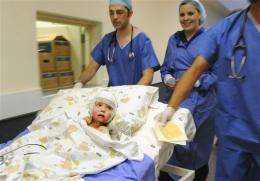South Africa burn survivor gets cloned skin grafts

(AP) — A 3-year-old South African girl who suffered severe burns over 80 percent of her body after an accident at a family barbecue has successfully undergone a rare surgery in Africa that gave her a new layer of cloned skin, her surgeon said.
"Everything went quite smoothly," said Dr. Ridwan Mia, a plastic and reconstructive surgeon who performed the surgery Monday in a Johannesburg hospital. "She is sedated at the moment but she did well overnight."
Isabella Kruger was injured on New Year's Eve when a container of fire lighting fluid exploded. Mia said he did not hold much hope for her survival when he met her in January. Burn victims with injuries as severe as Isabella's rarely survive, he said.
"She had swelled to three times her size from her injuries," Mia said of the toddler on Tuesday.
Isabella was in the hospital for several months battling pneumonia and kidney failure, and suffered several cardiac arrests. Doctors eventually stabilized her so that Monday's complex skin transplant surgery could be performed.
Mia and his team used enough cloned skin during the surgery to cover a placemat and stapled it in pieces onto Isabella's wounds. On her face, doctors used absorbent stitch material instead of staples. The new skin had been created by cloning two samples of skin taken from one of the few parts of Isabella's body to escape injury thanks to a diaper she was wearing at the time of the accident.
The samples were sent to Genzyme laboratory in Boston where the skin was cloned using mouse cells as a scaffold. The procedure has been used often in the U.S. and Europe but rarely in Africa, Mia said.
On Monday evening, a special courier arrived from Boston with a stainless steel container carrying about 30 to 40 grafts of Isabella's new skin. Thin, delicate and almost transparent, the skin was taken to a Johannesburg hospital by ambulance from the airport. The skin needed to be grafted onto Isabella within 24 hours of leaving the laboratory.
"It was like clockwork the way the skin arrived on time," said Mia.
As Isabella was wheeled out of the surgery, her father Erwin Kruger expressed his relief to reporters.
"Everything looks great, it's fantastic," he said.
Isabella's mother, Anice Kruger, who has been by her daughter's bedside since the accident, looked equally relieved.
For the next seven days Isabella will be wrapped in foam and protective dressing. She faces two immediate challenges. The first is ensuring that she remains free of infection. The second challenge is to prevent the new skin from sliding off and not taking. Skin grafts are delicate and prone to tearing. Doctors will have to keep Isabella sedated to minimize the risk of tearing.
Bronwen Jones, founder of the Children of Fire, a local charity dedicated to providing medical treatments for young burn survivors considers Isabella to be one of the luckier burn victims. Jones says their survival in South Africa often depends on their proximity to a hospital and whether the hospitals are properly equipped.
While there are no reliable statistics, Jones estimates that around 15,000 children are seriously injured every year. In impoverished areas the use of candles, paraffin stoves and open fires are often the causes of fire, particularly during the winter months. Tembisa Hospital, in the Gauteng province of South Africa, currently has 12 children in their burns unit.
In the case of Isabella, access to medical care at an early stage as well as her parent's ability to raise money through social networking sites have all helped ease the burden.
Mia will be able to tell whether the skin has successfully taken after two weeks but he is optimistic given Isabella's determination.
"She is a fighter," says Mia.
More information: Children of Fire: www.childrenoffire.org/
Copyright 2012 The Associated Press. All rights reserved. This material may not be published, broadcast, rewritten or redistributed.















